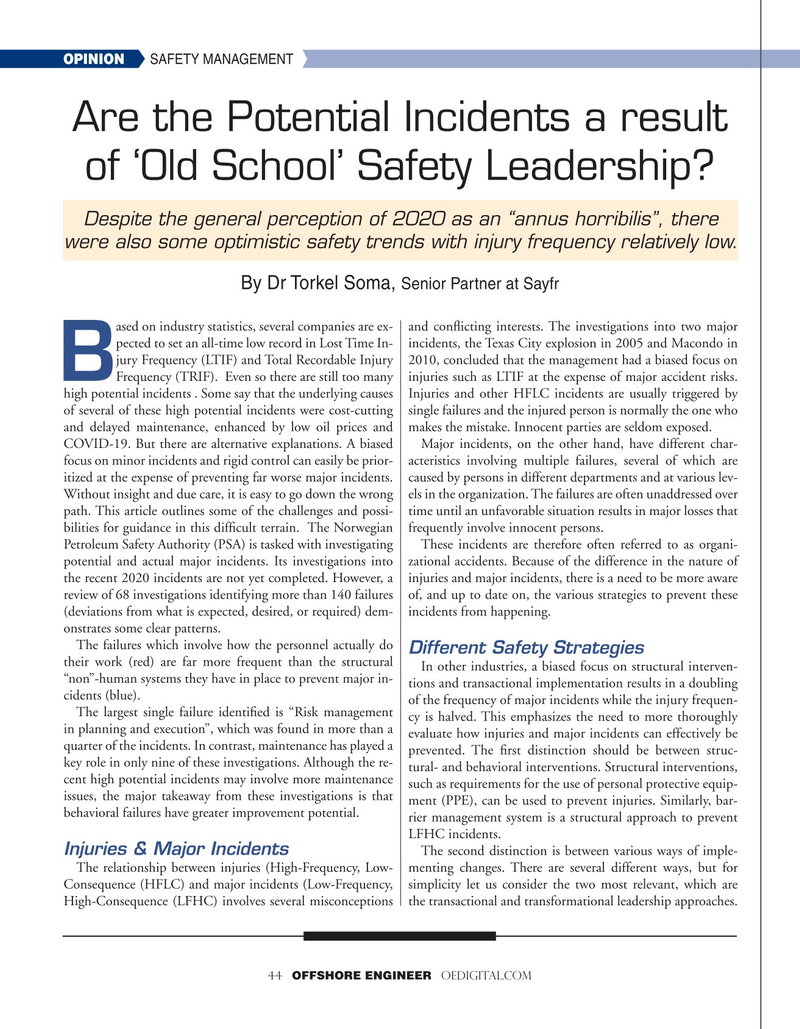
Page 44: of Offshore Engineer Magazine (Jan/Feb 2021)
Floating Production Outlook
Read this page in Pdf, Flash or Html5 edition of Jan/Feb 2021 Offshore Engineer Magazine
OPINION SAFETY MANAGEMENT
Are the Potential Incidents a result of ‘Old School’ Safety Leadership?
Despite the general perception of 2020 as an “annus horribilis”, there were also some optimistic safety trends with injury frequency relatively low.
By Dr Torkel Soma, Senior Partner at Sayfr ased on industry statistics, several companies are ex- and con?icting interests. The investigations into two major pected to set an all-time low record in Lost Time In- incidents, the Texas City explosion in 2005 and Macondo in jury Frequency (LTIF) and Total Recordable Injury 2010, concluded that the management had a biased focus on
B
Frequency (TRIF). Even so there are still too many injuries such as LTIF at the expense of major accident risks. high potential incidents . Some say that the underlying causes Injuries and other HFLC incidents are usually triggered by of several of these high potential incidents were cost-cutting single failures and the injured person is normally the one who and delayed maintenance, enhanced by low oil prices and makes the mistake. Innocent parties are seldom exposed.
COVID-19. But there are alternative explanations. A biased Major incidents, on the other hand, have different char- focus on minor incidents and rigid control can easily be prior- acteristics involving multiple failures, several of which are itized at the expense of preventing far worse major incidents. caused by persons in different departments and at various lev-
Without insight and due care, it is easy to go down the wrong els in the organization. The failures are often unaddressed over path. This article outlines some of the challenges and possi- time until an unfavorable situation results in major losses that bilities for guidance in this dif?cult terrain. The Norwegian frequently involve innocent persons.
Petroleum Safety Authority (PSA) is tasked with investigating These incidents are therefore often referred to as organi- potential and actual major incidents. Its investigations into zational accidents. Because of the difference in the nature of the recent 2020 incidents are not yet completed. However, a injuries and major incidents, there is a need to be more aware review of 68 investigations identifying more than 140 failures of, and up to date on, the various strategies to prevent these (deviations from what is expected, desired, or required) dem- incidents from happening. onstrates some clear patterns.
The failures which involve how the personnel actually do
Different Safety Strategies their work (red) are far more frequent than the structural
In other industries, a biased focus on structural interven- “non”-human systems they have in place to prevent major in- tions and transactional implementation results in a doubling cidents (blue). of the frequency of major incidents while the injury frequen-
The largest single failure identi?ed is “Risk management cy is halved. This emphasizes the need to more thoroughly in planning and execution”, which was found in more than a evaluate how injuries and major incidents can effectively be quarter of the incidents. In contrast, maintenance has played a prevented. The ?rst distinction should be between struc- key role in only nine of these investigations. Although the re- tural- and behavioral interventions. Structural interventions, cent high potential incidents may involve more maintenance such as requirements for the use of personal protective equip- issues, the major takeaway from these investigations is that ment (PPE), can be used to prevent injuries. Similarly, bar- behavioral failures have greater improvement potential. rier management system is a structural approach to prevent
LFHC incidents.
The second distinction is between various ways of imple-
Injuries & Major Incidents
The relationship between injuries (High-Frequency, Low- menting changes. There are several different ways, but for
Consequence (HFLC) and major incidents (Low-Frequency, simplicity let us consider the two most relevant, which are
High-Consequence (LFHC) involves several misconceptions the transactional and transformational leadership approaches. 44 OFFSHORE ENGINEER OEDIGITAL.COM

 43
43

 45
45